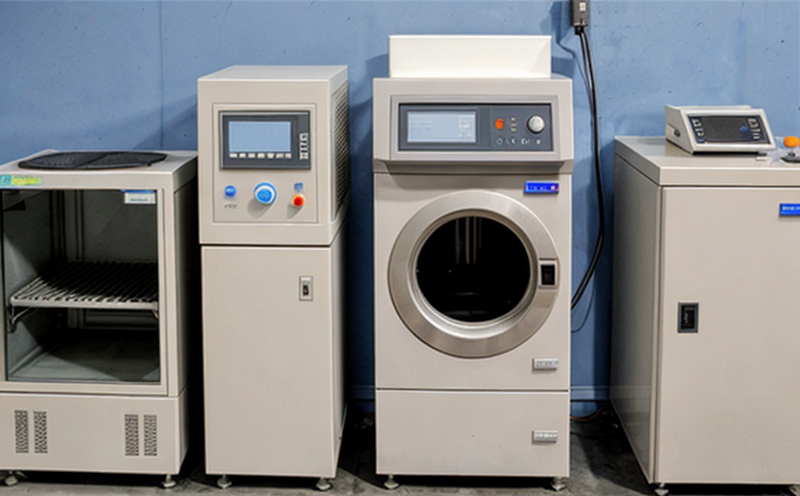ASTM D4512 Colloidal Stability Evaluation of Nanomaterial Dispersions
The ASTM D4512 standard specifies a method for evaluating colloidal stability in nanomaterial dispersions. This is particularly important as nanomaterials are increasingly used across various sectors, including pharmaceuticals, cosmetics, electronics, and environmental science. Ensuring that these materials remain stable over time is crucial to their effectiveness and safety.
The process involves dispersing the nanomaterial in a suitable solvent or medium under controlled conditions. The stability of the dispersion is then assessed by monitoring changes in particle size distribution, zeta potential, viscosity, and other relevant parameters. Stability can be compromised if there are agglomerations or sedimentation processes that lead to a loss of uniformity.
The ASTM D4512 method is designed to provide quantitative data on the stability of colloidal dispersions over time. This helps in understanding how nanomaterials behave under real-world conditions, such as storage and use. It allows manufacturers and researchers to make informed decisions about their formulations and processes. By adhering to this standard, companies can ensure that their products meet regulatory requirements and perform consistently.
The testing procedure typically involves the following steps:
- Preparation of a nanomaterial dispersion using appropriate solvents or media
- Stirring at controlled conditions for a specified period
- Sampling at regular intervals to analyze particle size distribution, zeta potential, and other relevant parameters
- Data analysis to determine colloidal stability over time
The results of the ASTM D4512 test can be used in various ways:
- To ensure product quality and consistency across batches
- To optimize manufacturing processes for greater efficiency and less waste
- To identify potential issues early in development, reducing costly failures later on
- To meet regulatory requirements for the safe use of nanomaterials
Understanding colloidal stability is critical for ensuring that nanomaterial dispersions remain effective over their intended lifespan. This is especially important when dealing with materials used in sensitive applications, such as pharmaceuticals or environmental remediation.
| Parameter | Description | Methodology |
|---|---|---|
| Particle Size Distribution | Determines the range of particle sizes present in the dispersion | Electrospray laser diffraction (ELSD) |
| Zeta Potential | Measures the degree of electrical charge on the surface of nanoparticles | Barnstead Zetasizer |
| Viscosity | Metric for fluid thickness; relevant in understanding flow properties | Brookfield rheometer |
| Sedimentation Rate | Indicates the rate at which particles settle out of suspension | Digital sedimentation meter |
The ASTM D4512 test is a key tool in the development and quality control of nanomaterials. It allows for precise monitoring of colloidal stability, ensuring that materials perform as expected under real-world conditions.
Applied Standards
| Standard | Description |
|---|---|
| ASTM D4512-18 | Standard Test Method for Colloidal Stability of Nanomaterial Dispersions |
| ISO 13390-1:2016 | Particle Size Analysis - Laser Diffraction Methods - Part 1: General Principles and Characterization |
| ASTM D5294-18 | Standard Practice for Calculation of Zeta Potential from Electrokinetic Measurements |
| ISO 3217:2006 | Rheological Measurement - Determination of Viscosity and Related Properties by Capillary Viscometer Methods |
The ASTM D4512 method is supported by a number of international standards that provide additional context and methodologies. These include ISO 13390 for particle size analysis, ASTM D5294 for zeta potential calculations, and ISO 3217 for rheological measurements.
Eurolab Advantages
EuroLab is uniquely positioned to provide top-tier nanomaterial dispersion testing services. Our state-of-the-art facilities are equipped with the latest instrumentation and expertise in nanotechnology. Here are some of the advantages we offer:
- Accurate Measurements: Our laboratory uses cutting-edge technology, including electrospray laser diffraction (ELSD) for precise particle size distribution analysis.
- Comprehensive Analysis: We provide a full suite of parameters that are critical to colloidal stability evaluation. This includes zeta potential, viscosity, and sedimentation rate.
- Expertise: Our team of scientists has extensive experience in nanotechnology and can provide valuable insights into your testing needs.
- Regulatory Compliance: Our services are designed to meet the highest regulatory standards, ensuring that your products are safe and effective.
- Timely Turnaround: We understand the importance of timely results in product development. Our efficient processes allow for rapid turnaround times without compromising quality.
EuroLab's commitment to excellence and innovation ensures that you receive reliable, accurate, and actionable data on colloidal stability. This is crucial for maintaining high standards in your products and processes.
Use Cases and Application Examples
- Polymer Nanocomposites: Ensuring that nanofillers remain dispersed in polymer matrices to enhance mechanical properties.
- Cosmetics: Evaluating the stability of nanoparticle-based emulsions for cosmetics applications.
- Bio-Nanoparticles: Assessing colloidal stability for bio-nanoparticles used in drug delivery systems.
- Solar Cells: Monitoring the dispersion and stability of quantum dots in photovoltaic cells to improve efficiency.
- Water Treatment: Evaluating the effectiveness of nanomaterial-based water treatment processes by assessing colloidal stability over time.
The ASTM D4512 test is particularly valuable for industries where maintaining colloidal stability is critical. By using this standard, companies can ensure that their products perform as expected in real-world applications.





